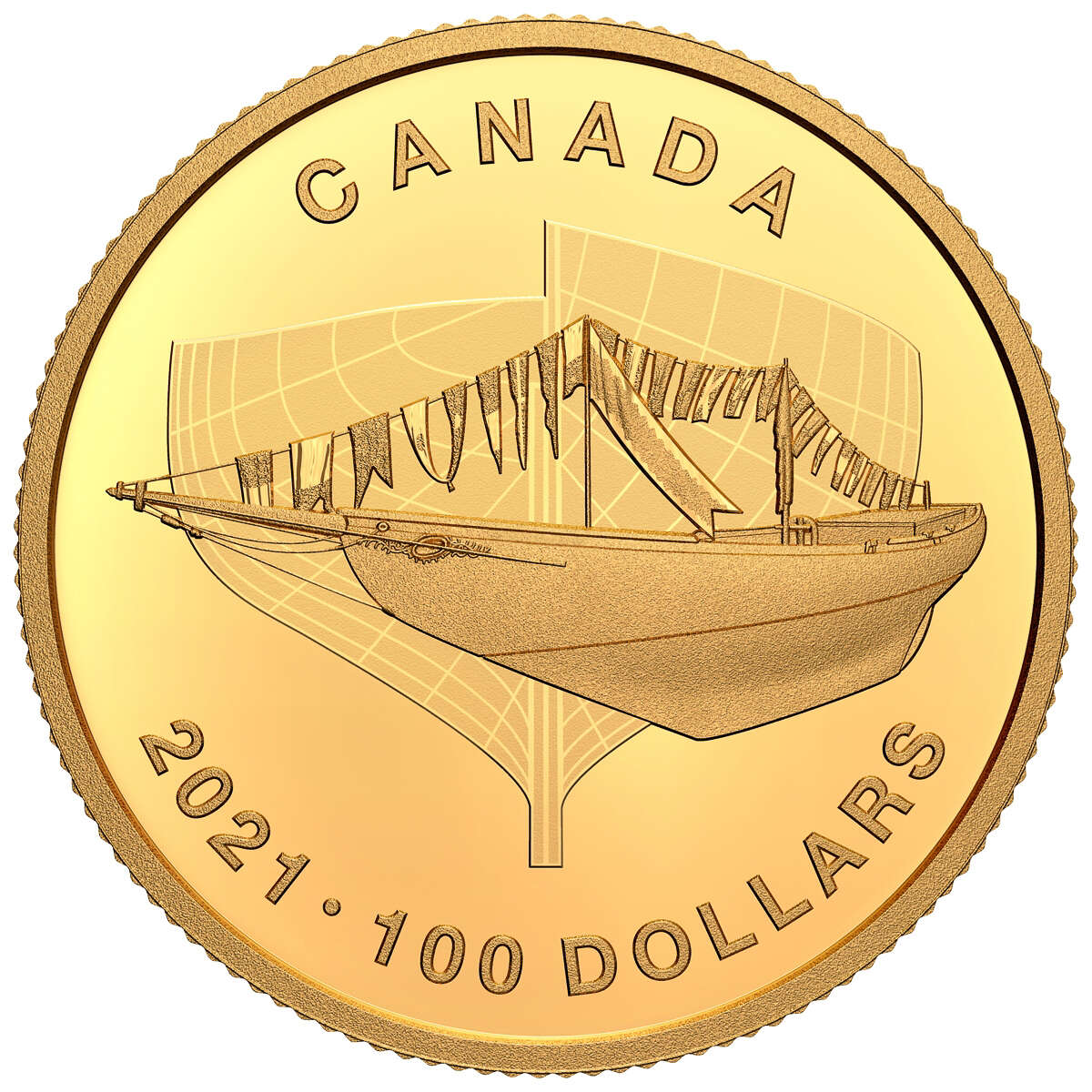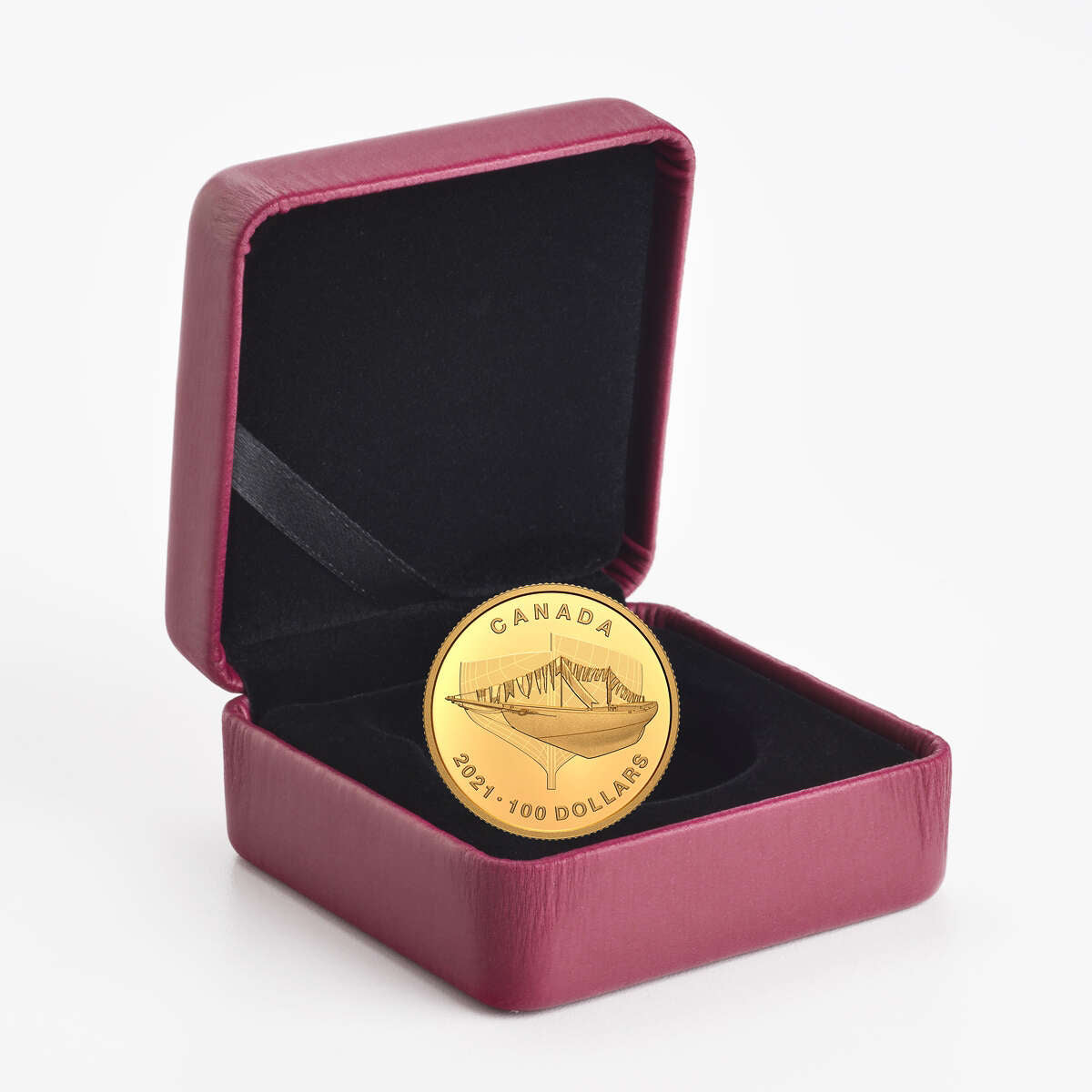Description
This 2021 quarter ounce $100 pure gold coin marks the 100th anniversary of the launch of the Bluenose Schooner, a fishing and racing craft that has become a symbol of Canadian excellence and ingenuity. The schooner is presented through two images that are precisely aligned to create a contrasting effect. In the background, the hull drawing focuses on the streamlined design and clean lines that contributed to the ship’s successful racing career. In the foreground, the Bluenose is seen without sails and dressed in an array of signal flags based on a launch day (March 26, 1921) photograph. The use of a forced perspective emphasizes the bow and adds a sense of movement. Mintage is limited to 2,000 pieces. HST/GST exempt.
The story behind the Bluenose can be traced back to 1919, when the hearty fishermen of the Canadian Maritimes scoffed at the America’s Cup race being cancelled because of “strong winds”. While the America’s cup was a race of “recreational yachts”, the fishermen sought to establish their own contest. In 1920, the International Fishermen’s Trophy was established as a prize for “the fastest ship in the North Atlantic fishing fleet”, with a requirement that any ship entered had to be a true working fishing vessel.
Canada faced a great challenge with this new race, as the American fishing vessels were usually smaller and faster. In 1920, the inaugural race was won by a ship from Gloucester, Massachusetts, and the Canadians vowed to defeat their rivals the following year. It was this challenge that inspired Halifax businessmen and Captain Angus Walters to commission W.J. Roué to design a sleek new ship that could beat the New England rivals.
The new Bluenose schooner was completed in early 1921 and was designed both as a working fishing vessel and a racing craft. With Angus Walters at the helm, the Bluenose triumphed in its first race, and the ship remained undefeated through an 18 year career.
A Winner By Design
In the Smith and Rhuland shipyard in Lunenburg, N.S., the construction methods were the same ones that had built more than 100 vessels, but Bluenose’s design set it apart. Its architect, William James Roué, had envisioned a sleek-looking schooner that would be a “combination of Gloucester and Nova Scotian vessels, with the depth of the former and the breadth of the latter." Through theory and calculations, Roué drafted the blueprint for a vessel with a large carrying capacity and a hull that was optimized for reduced resistance. Bluenose was built according to Roué’s plans and specifications, with the exception of one modification that raised the forecastle and gave Bluenose more forward sheer.
The story behind the Bluenose can be traced back to 1919, when the hearty fishermen of the Canadian Maritimes scoffed at the America’s Cup race being cancelled because of “strong winds”. While the America’s cup was a race of “recreational yachts”, the fishermen sought to establish their own contest. In 1920, the International Fishermen’s Trophy was established as a prize for “the fastest ship in the North Atlantic fishing fleet”, with a requirement that any ship entered had to be a true working fishing vessel.
Canada faced a great challenge with this new race, as the American fishing vessels were usually smaller and faster. In 1920, the inaugural race was won by a ship from Gloucester, Massachusetts, and the Canadians vowed to defeat their rivals the following year. It was this challenge that inspired Halifax businessmen and Captain Angus Walters to commission W.J. Roué to design a sleek new ship that could beat the New England rivals.
The new Bluenose schooner was completed in early 1921 and was designed both as a working fishing vessel and a racing craft. With Angus Walters at the helm, the Bluenose triumphed in its first race, and the ship remained undefeated through an 18 year career.
A Winner By Design
In the Smith and Rhuland shipyard in Lunenburg, N.S., the construction methods were the same ones that had built more than 100 vessels, but Bluenose’s design set it apart. Its architect, William James Roué, had envisioned a sleek-looking schooner that would be a “combination of Gloucester and Nova Scotian vessels, with the depth of the former and the breadth of the latter." Through theory and calculations, Roué drafted the blueprint for a vessel with a large carrying capacity and a hull that was optimized for reduced resistance. Bluenose was built according to Roué’s plans and specifications, with the exception of one modification that raised the forecastle and gave Bluenose more forward sheer.
**This product features dynamic pricing, which adjusts in real-time based on spot metal market prices. The price may fluctuate to reflect current market conditions, ensuring accurate and competitive pricing at the time of purchase.**
‘Bluenose’ is an official mark adopted and used by the Nova Scotia Department of Communities, Culture and Heritage pursuant to the Trade-marks Act (Canada). It is used by the Royal Canadian Mint with the Department’s permission.
‘Bluenose’ is an official mark adopted and used by the Nova Scotia Department of Communities, Culture and Heritage pursuant to the Trade-marks Act (Canada). It is used by the Royal Canadian Mint with the Department’s permission.
William James Roué Signature © jeroué. Used with permission.
Blueprints of 1921 BLUENOSE © jeroué. Used with permission.





